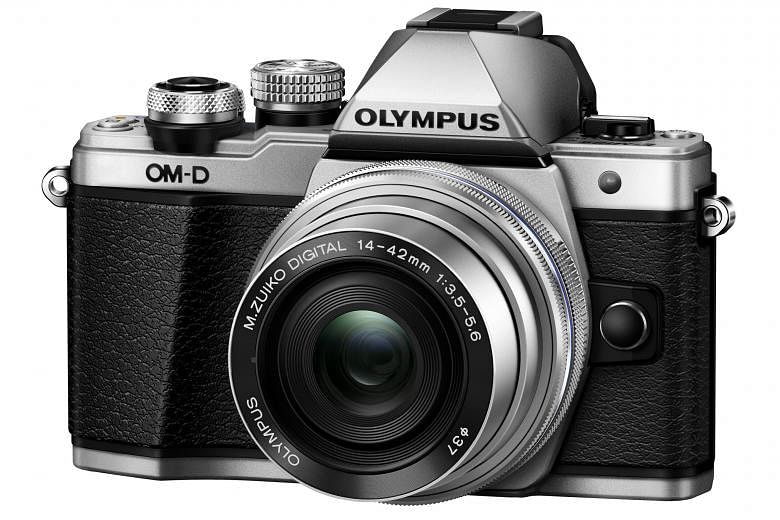The OM-D name represents Olympus' top Micro Four Thirds interchangeable lens mirrorless camera series.
The entry-level model of this series is the OM-D E-M10. And its Mark II version is here.
Among the improvements are a built-in five-axis image-stabilisation (IS) feature - its predecessor has a three-axis IS - and a 2.36-million-dot electronic viewfinder (EVF) which has almost twice the resolution of the original. Full high-definition video frame rate is now from 24 frames per second (fps) to 60fps, instead of the original's 30fps.
There is also a new autofocusing (AF) targeting pad, and the camera body is lighterby 6g.
The camera comes in all-black or black/silver models. We reviewed the more classic-looking latter, with the M.Zuiko 14-42mm f/3.5-5.6 kit lens.

As an entry-level model, the E-M10 Mark II does not have premium touches like a weather-resistant magnesium body, or a multitude of dedicated buttons and controls.
It is not very big. The grip does not have room for my fourth finger and pinkie. Not exactly very comfortable, but the compact size might be a boon to some.
-
TECH SPECS
PRICE: $1,148 (with M.Zuiko 14-42mm f/3.5-5.6 lens)
IMAGE SENSOR: 16-megapixel Micro Four Thirds Live MOS
DISPLAY: 3-inch tiltable touchscreen with 1.04 million dots; built-in electronic viewfinder with 2.36 million dots
SENSITIVITY: ISO 100-25,600
SHOOTING SPEED: Up to 8.5 frames per second
CONNECTIVITY: Wi-Fi
WEIGHT: 390g (body only, with battery and memory card)
-
RATING
FEATURES: 4/5
DESIGN: 4/5
PERFORMANCE: 4/5
BATTERY LIFE: 3/5
VALUE FOR MONEY: 4/5
OVERALL: 4/5
Nonetheless, the camera iswell built, with a metallic body. The mode and control dials also have a metallic finish with knurled patterns that make them easy to turn.
Button layout is well thought out, with the top mode dial and two control dials in close proximity. The shutter release button is on the front control dial, with a customisable Function button beside it. This makes changing of settings easy. Overall, handling is superb for an entry-level model.
Other than the rear four-way directional pad, you can also use the AF targeting pad to change focus point by moving your thumb on the touchscreen display while your eye is still on the EVF. Pretty neat.
I also like the new high-resolution EVF, which looks really sharp. The simulated optical viewfinder function improves viewing visibility by enhancing the dynamic range of the EVF, making it seem like I am looking at real objects and not a video feed when composing shots.
The built-in five-axis IS lets me shoot at shutter speeds as slow as 1/5sec and still get a sharp image. It also makes video recordings stable, even those I shot while walking.
The overall AF performance is really good. In bright conditions, I got immediate focus lock. This slowed by up to 1sec in dim light with the aid of AF assist lighting - versus the typical 2sec for comparable cameras. During video recording, focus lock took no more than 2sec when I panned to a new scene.
Using an SD card with a writing speed rated at 45MB per second, the camera shot 11 RAW images in 1.2sec before the buffer ran out.
Images are beautifully rendered with crisp details and rich vivid colours. You get visible image noise artefacts only at ISO 1,600, compared with ISO 800 with the original model. The ISO 3,200 shots are still acceptable for Web use, but not so for print.
Video quality is good. It picks up a fair bit of wind, ambient audio and the sound of the lens zoom. But not to the point of being distracting.
Battery life is around 320 frames on a full charge, which is average for mirrorless cameras.
- Verdict: If you do not require the magnesium alloy or multiple buttons, the Olympus OM-D E-M10 Mark II is the best-value mirrorless camera you can buy right now.


